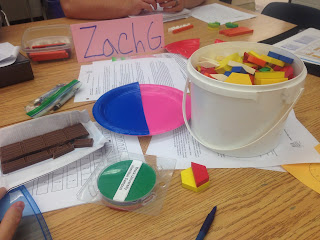The last class was another new experience for me, bringing new topic and teaching methods to my attention, as well as different ways to solve a single problems. the classes focus this week was fractions and all of the different parts and aspects of teaching and learning the topic if fractions in class. What I found important about the lesson on fractions is how easily relatable it is to real-life situations, which is what we want in order to keep the class involved and help them understand the importance of the lesson.
Take the example of 1/4 or 1 quarter. How many ways can you express that?
25%, 12 to 3 on the clock, which relates to people saying "a quarter after 6", 25 cents of the dollar etc.
A simple fraction related to 3 different things easily.
We then went into the addition and subtraction of fractions and how to explain why we don't add the denominators when adding (because it is a part of a whole) and the overall definition of a fraction to explain to our class.
Definition: a part of a whole number
Characteristics: numerator, denominator, division, percentage, ratio
Examples: 1/4, 25%, 0/4, 4/1
Non- Examples: 14
What I liked was the discussion of what us as teachers want our questions to lead to, our question goals. This had me thinking what I want personally out of the questions I ask during class time. Fearless speaking and sharing is something I consider important. I want my students to be able to discuss together as a group and as a class, even with me, aspects of the problem. When in a group and they are sharing their ideas the different types learners will be able to collaborate, which will lead to various answers and inclusion. This also evokes thinking, because having open questions there will be different answers and when the different earners are discussing their answers, they will be able to see the questions the different ways their peers do.
Finally, I really enjoy using physical manipulatives, because I was never given the opportunity to learn this way, I am able to take these ideas and apply them to my class room along with some of the learning styles I have from when I was in school.
The pictures above are simples ways to have students represent fractions using physical manipulatives that can be found almost anywhere. Chocolate also works great!
Overall the lesson on fractions was intriguing, learning different ways to express fractions and represent them in real-life is new to me, because of the way I have been taught, meaning I am both learning as a student (ways to do these myself) and as a teacher (ways to incorporate into the classroom).



Hi Matt, Great post for this week. I couldn't agree with you more. As a student, I was always worried about speaking up in class for saying the wrong answer or looking silly but I think that it is extremely important to try to create a fearless speaking mindset within the classroom. If we can provide our students with word problems and activities where they can immediately jump in, collaborate with friends, and enjoy what they are doing then I think that will make the speaking and sharing within the classroom come naturally. I really like the idea of open ended questions because anyone can work on these problems and start thinking mathematically.
ReplyDeleteKeep up the good work.
Kevin
Hey Matt, I totally agree with you on the importance of students discussing with each other in order to make sense of math problems. Though some students might feel uncomfortable with this, I think it is a necessary skill for them to develop that will be beneficial to them in their future. I also enjoy using the manipulatives because of its way of helping me visualize math, a skill that I think could help many students.
ReplyDelete